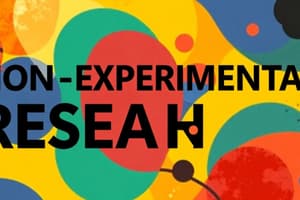Podcast
Questions and Answers
What does high internal validity indicate regarding a study's results?
What does high internal validity indicate regarding a study's results?
- Findings are likely applicable in diverse settings.
- The study used a non-representative sample.
- Results can be influenced by unrelated variables.
- Other explanations for the results have been ruled out. (correct)
Which question is primarily concerned with internal validity?
Which question is primarily concerned with internal validity?
- Can the study findings be generalized?
- Is the study methodologically sound? (correct)
- Are the findings affected by external influences?
- How do the results apply to the real world?
Which of the following is considered a threat to internal validity?
Which of the following is considered a threat to internal validity?
- Non-representative samples.
- Artificial settings.
- Limited ecological validity.
- Confounding variables. (correct)
What is the focus of external validity?
What is the focus of external validity?
In a pre-post study, what is the first step of the structure?
In a pre-post study, what is the first step of the structure?
Which aspect is critical for ensuring the observed effects in an experiment are real?
Which aspect is critical for ensuring the observed effects in an experiment are real?
What is one primary concern of external validity?
What is one primary concern of external validity?
Which factor does NOT relate to internal validity?
Which factor does NOT relate to internal validity?
What is a primary purpose of correlational research?
What is a primary purpose of correlational research?
Which statement correctly describes a limitation of experimental research?
Which statement correctly describes a limitation of experimental research?
Which of the following best defines independent variables in experimental research?
Which of the following best defines independent variables in experimental research?
What distinguishes experimental research from correlational research?
What distinguishes experimental research from correlational research?
What feature must be present in an experimental design?
What feature must be present in an experimental design?
Which of the following is NOT a characteristic of correlational research?
Which of the following is NOT a characteristic of correlational research?
What is a potential advantage of using correlational research?
What is a potential advantage of using correlational research?
Why might an experimental research study face ethical limitations?
Why might an experimental research study face ethical limitations?
What is the primary goal of random assignment in experimental design?
What is the primary goal of random assignment in experimental design?
Which of the following is a disadvantage of within-subjects design?
Which of the following is a disadvantage of within-subjects design?
In single-factor designs, what does the term 'factor' refer to?
In single-factor designs, what does the term 'factor' refer to?
What defines manipulated variables in research?
What defines manipulated variables in research?
What is an important condition for using matching instead of random assignment?
What is an important condition for using matching instead of random assignment?
Which of the following best describes extraneous variables?
Which of the following best describes extraneous variables?
What issue may arise if condition A consistently comes before condition B in a within-subjects design?
What issue may arise if condition A consistently comes before condition B in a within-subjects design?
Which method is most effective in ensuring equivalent groups when dealing with a small sample size?
Which method is most effective in ensuring equivalent groups when dealing with a small sample size?
What is a key consequence of not controlling extraneous variables?
What is a key consequence of not controlling extraneous variables?
Which statement about subject variables is true?
Which statement about subject variables is true?
In the context of experimental designs, what does the term 'level' signify?
In the context of experimental designs, what does the term 'level' signify?
What is a common effect that can reduce the statistical power in a within-subjects design?
What is a common effect that can reduce the statistical power in a within-subjects design?
Which of the following is NOT a type of variable mentioned in the content?
Which of the following is NOT a type of variable mentioned in the content?
How do instructional variables influence an experiment?
How do instructional variables influence an experiment?
Why is it crucial to control situational variables in an experiment?
Why is it crucial to control situational variables in an experiment?
Which of the following illustrates a potential confounding variable?
Which of the following illustrates a potential confounding variable?
What is the primary purpose of correlational research?
What is the primary purpose of correlational research?
What does a correlation coefficient of -0.8 indicate?
What does a correlation coefficient of -0.8 indicate?
Which of the following statements is true regarding correlational research?
Which of the following statements is true regarding correlational research?
Which design type examines the differences between groups in terms of variables without manipulating them?
Which design type examines the differences between groups in terms of variables without manipulating them?
Why is it crucial to remember that correlation does not imply causation?
Why is it crucial to remember that correlation does not imply causation?
In a study where higher levels of stress are found to correspond with lower academic performance, what type of research is being conducted?
In a study where higher levels of stress are found to correspond with lower academic performance, what type of research is being conducted?
Which factor can limit the complexity of a research study involving participant design?
Which factor can limit the complexity of a research study involving participant design?
What type of relationship does a correlation coefficient closer to +1 suggest?
What type of relationship does a correlation coefficient closer to +1 suggest?
Flashcards are hidden until you start studying
Study Notes
Research Methods
- Correlational Research: Examines the relationship between variables, observing natural occurrences without manipulation.
- Identifies associations between variables.
- Cannot establish causality.
- Uses observational, survey, and archival data.
- Advantages: Useful for large datasets and when manipulation is not possible.
- Limitations: Cannot infer causation; confounding variables may exist.
- Experimental Research: Establishes causality by manipulating variables and controlling for confounding factors.
- Employs controlled and randomized designs.
- Advantages: Provides strong evidence for cause-and-effect.
- Limitations: May lack generalizability and present ethical challenges.
Features of an Experiment
- Independent Variable (IV): The factor actively manipulated by the researcher to observe its effect on the dependent variable.
- Considered the "cause" in the cause-and-effect relationship.
- Requires at least two levels or conditions to allow for comparison.
- Levels can be manipulated (actively changed by the researcher) or subject variables (pre-existing participant traits).
- Dependent Variable (DV): The outcome or response being measured in an experiment.
- Extraneous Variables: Factors other than the IV that could influence the DV.
- Must be controlled to avoid confounding, which occurs when an extraneous variable changes systematically along with the IV.
- Leads to internal validity, meaning alternative explanations for results are ruled out.
- Internal Validity: Focuses on establishing a cause-and-effect relationship within the study.
- Ensures changes in the DV are due to the IV, not other influences.
- Threats include confounding variables, selection bias, maturation, history, and demand characteristics.
- External Validity: Focuses on generalizing research findings to broader contexts outside the study.
- Concerns whether results apply to other populations, settings, or times.
- Threats include non-representative samples, artificial settings, and limitations in ecological or population validity.
Pre-Post Studies
- Structure: Measure DV before treatment (pretest), apply IV (treatment), then measure DV again (posttest).
- Steps to Conduct:
- Identify the research question and define the IV and DV.
- Ensure pre-test conditions don't influence post-test conditions.
Between-Subjects Designs
- Used when IV is a subject variable (e.g., extroversion, marital status).
- Employs random assignment (distributing individual factors evenly across groups) and matching (creating comparable groups on a matching variable).
Within-Subjects Designs
- Advantages: Fewer participants needed, no problems with equivalent groups, increased statistical power.
- Disadvantages: Practice effects, fatigue effects, and carryover effects (impact of previous condition on the current one).
Single-Factor Designs
- Focus on one independent variable (factor) and examine its effect on a dependent variable.
- Vocabulary:
- Factor: The independent variable being tested.
- Level: The different variations or states of the factor being investigated.
Correlational Research
- Examines the relationship between two or more variables without manipulation.
- Key Points:
- Identifies statistical relationships between variables.
- Uses correlation coefficient to measure relationship strength and direction (-1 to +1).
- Does not imply causation.
Studying That Suits You
Use AI to generate personalized quizzes and flashcards to suit your learning preferences.




